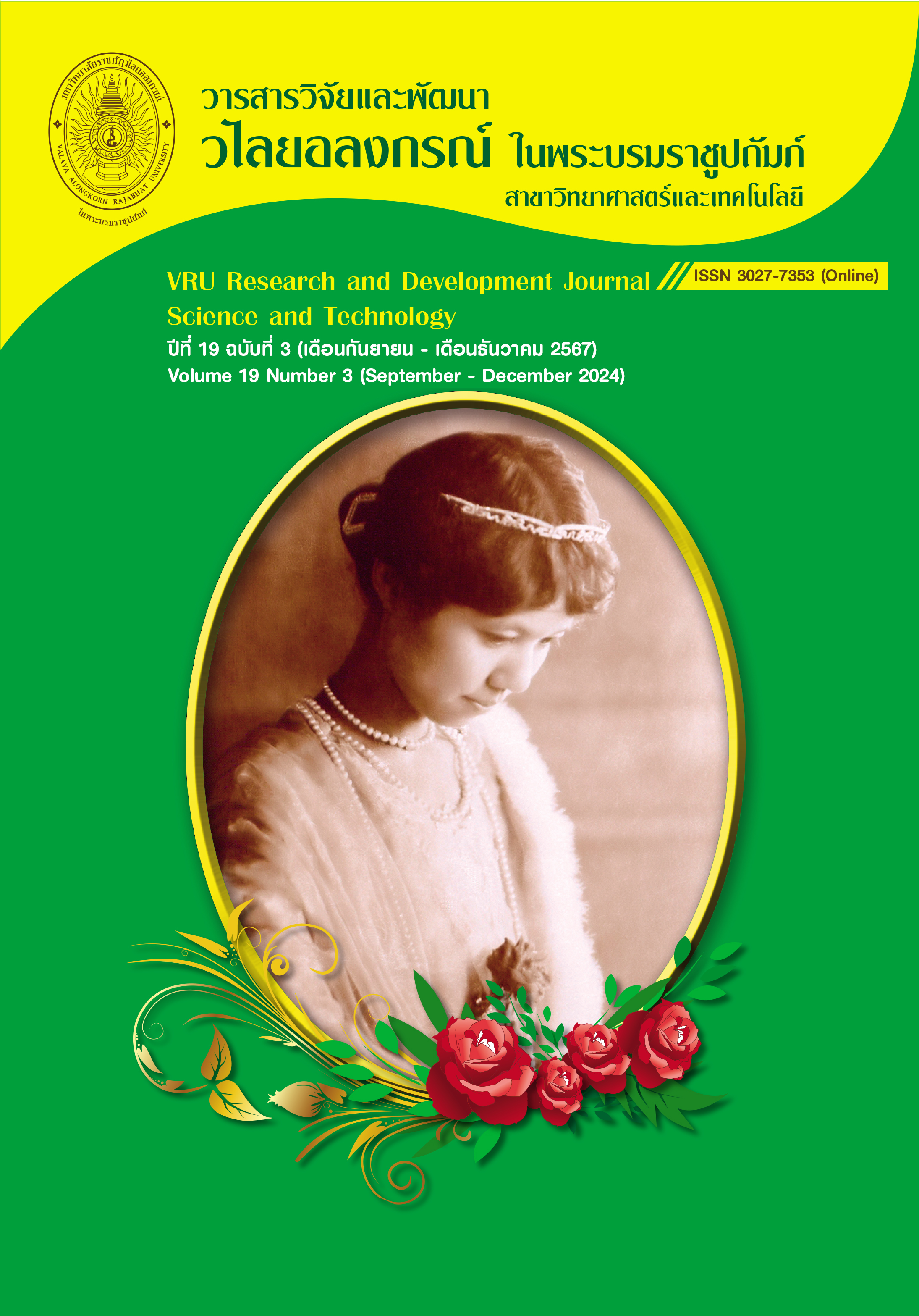UTILIZATION OF WHITE POMELO PEEL TO REPLACE SOME OF THE ORANGE PULP IN JAM PRODUCTS
Main Article Content
Abstract
The objectives of this research were 1) to develop a basic jam recipe, 2) to determine the appropriate amount of white pomelo peel in jam products, 3) to analyze the physical and chemical properties of the jam, and 4) to evaluate consumer acceptance of jam made with white pomelo peel. The study found that out of four basic orange jam recipes, Formula 3 was the most preferred by tasters in all aspects. This recipe, which contained a high amount of orange pulp and sugar, was ideal for making jam without the addition of citric acid, relying instead on the natural balance of orange pulp and sugar for its flavor. The optimal ratio of white pomelo peel in jam, according to tasters, was 60:40, with appearance, color, smell, flavor, texture, and overall liking scores of 7.40, 7.15, 7.15, 7.20, 7.20, and 7.50, respectively, indicating a moderate level of acceptance. The jam had a glossy and viscous texture that broke apart well when stirred. However, increasing the amount of white pomelo peel reduced the jam's viscosity and luster. The chemical composition of the 60:40 white pomelo peel jam (Formula 2) was found to be 157 Kcal energy, 0.1% fat, 38.9% carbohydrates, 32.2% sugar, 120 mg sodium, 60.44% moisture, and 0.34% ash. Physically, the jam had a brightness value (L*) of 30.90, a green value (a*) of 5.50, and a yellow value (b*) of 32.99. Consumer testing revealed that white pomelo peel could potentially replace orange pulp in jam products. Sensory acceptance scores for appearance, color, aroma, taste, and overall liking were 7.58, 7.36, 7.39, 8.75, and 8.28, respectively, indicating a moderate to high level of liking. Additionally, 82% of consumers accepted the use of white pomelo peel as a substitute for orange pulp in jam products, while 18% did not.
Downloads
Article Details
ลิขสิทธิ์บทความวิจัยที่ได้รับการตีพิมพ์เผยแพร่ในวารสารวิจัยและพัฒนา วไลยอลงกรณ์ ในพระบรมราชูปถัมภ์ ถือเป็นกรรมสิทธิ์ของสถาบันวิจัยและพัฒนา มหาวิทยาลัยราชภัฏวไลยอลงกรณ์ ในพระบรมราชูปถัมภ์ ห้ามนำข้อความทั้งหมดหรือบางส่วนไปพิมพ์ซ้ำ เว้นแต่จะได้รับอนุญาตจากมหาวิทยาลัยเป็นลายลักษณ์อักษร
ความรับผิดชอบ เนื้อหาต้นฉบับที่ปรากฏในวารสารวิจัยและพัฒนา วไลยอลงกรณ์ ในพระบรมราชูปถัมภ์ เป็นความรับผิดชอบของผู้นิพนธ์บทความหรือผู้เขียนเอง ทั้งนี้ไม่รวมความผิดพลาดอันเกิดจากเทคนิคการพิมพ์
References
ครัวพิศพิไร. (ม.ป.ป). แยมส้ม. สืบค้นจาก https://www.youtube.com/watch?v=wfpWRnJD7ko&ab_channel=ครัวพิศพิไร
จรรยา โท๊ะนาบุตร. (2564ก). การพัฒนาผลิตภัณฑ์ขนมโสมนัสเสริมใยอาหารจากเปลือกส้มโอ. วารสารวิจัยและพัฒนาวไลยอลงกรณ์ ในพระบรมราชูปถัมภ์, 16(1), 1-15.
จรรยา โท๊ะนาบุตร. (2564ข). การพัฒนาผลิตภัณฑ์แยมกระเจี๊ยบผสมอินทผาลัมจากใบเครือหมาน้อย. วารสารวิทยาศาสตร์ชีวภาพและสิ่งแวดล้อม, 22(1), 97-111.
ณวรา เปลี่ยนบุญเลิศ. (2562). ศาสตร์แห่งแยมหวานและเปรี้ยว. สืบค้นจาก https://krua.co/cooking_post/sweetsourfruitjam
เบียร์ เลิฟทูอีทส์. (ม.ป.ป). แยมส้ม. สืบค้นจาก https://www.youtube.com/watch?v=ZCRjlg8KilI&ab_channel=Love2EatByMizaki
ผกามาศ ราชมนตรี, อิสราภรณ์ สมบุญวัฒนกุล, ญาณิศา บรรยง, ศิโรรัตน์ ศรีชื่น, และธิดารัตน์ แก้วเนตร. (2563). การผลิตแยมมะม่วงมหาชนกผสมมันแกว. วารสารวิทยาศาสตร์และเทคโนโลยี มหาวิทยาลัยราชภัฏอุดรธานี, 8(2), 75-87.
พิมพ์มี่ เทสตี้. (ม.ป.ป). แยมส้ม. สืบค้นจาก https://www.youtube.com/watch?v=ptQAuyam4-w&ab_channel=PIMMYTASTY
มาดามตวง. (ม.ป.ป). แยมส้ม. สืบค้นจาก https://www.youtube.com/watch?v=rQ9UjHdYm9w&ab_channel=MadameTuang
วันเพ็ญ แสงทองพินิจ. (2553). การเสริมใยอาหารจากเปลือกส้มโอในผลิตภัณฑ์หมูยอ. การประชุมวิชาการครั้งที่ 48 มหาวิทยาลัยเกษตรศาสตร์ เล่มที่ 8 สาขาอุตสาหกรรมเกษตร (หน้า 269-276),
-6 กุมภาพันธ์ 2553 มหาวิทยาลัยเกษตรศาสตร์. กรุงเทพฯ: มหาวิทยาลัยเกษตรศาสตร์.
วิศณี วรรณนิยม. (2552). การพัฒนาแยมเสาวรสโดยใช้เพกทินจากเปลือกเสาวรส. วิทยานิพนธ์วิทยาศาสตร์มหาบัณฑิต, มหาวิทยาลัยเชียงใหม่.
สมคิด เทียมรัศมี. (2548). การปลูกส้มโอ. พิมพ์ครั้งที่ 2. กรุงเทพฯ: การพิมพ์อักษรสยาม.
สามารถ สายอุต, ลลิตา โชติพฤฒิพงศ์, จักรสุมา พงศ์เศรษฐ์กุล, นัฐวงค์ เฟื่องไพบูลย์, อภิรดี จันครา,
และสิริมา สินธุสำราญ. (2566). การพัฒนาผลิตภัณฑ์แยมมันม่วงผสมหอมแดง. วารสารวิทยาศาสตร์บูรพา, 28(2), 1-15.
เสาวภา ไชยวงศ์, ธีรพงษ์ เทพกรณ์, สุจริต ส่วนไพโรจน์, โรมรัน ชูศรี, และอุไรวรรณ ขุนจันทร์. (2553). การประเมินสารออกฤทธิ์สำคัญในกลุ่ม Flavonoids และAnthocyanins ของส้มโอพันธุ์ทองดี พันธุ์ขาวน้ำผึ้ง พันธุ์ขาวแตงกวา พันธุ์ขาวใหญ่ และพันธุ์ทับทิมสยามที่ปลูกในไทย. (รายงานผลการวิจัย). กรุงเทพฯ: สำนักงานคณะกรรมการส่งเสริมวิทยาศาสตร์ วิจัยและนวัตกรรม.
Adedeji, T. O. (2017). Development and quality evaluation of Jam from Watermelon (Citrullus Lanatus) and Pawpaw (Carica Papaya) juice. Agricultural and Food Sciences, 1(2), 63-71.
AOAC. (2016). Guidelines for Standard Method Performance Requirements. Retrieved from https://www.aoac.org/wp-content/uploads/2019/08/app_f.pdf
Cheong, M. W., Liu, S. Q., Zhou, W., Curran, P., & Yu, B. (2012). Chemical composition and sensory profile of pomelo (Citrus grandis (L.) Osbeck) juice. Food Chemistry, 135(4), 2505-2513.
Roy, M. C., Alam, M., Saeid, A., Das, B. C., Mia, M. B., Rahman, M. A., Eun, J. B., & Ahmed, M. (2018). Extraction and characterization of pectin from pomelo peel and its impact on nutritional properties of carrot jam during storage. Journal of Food Processing and Preservation, 42(1), 1-9.

